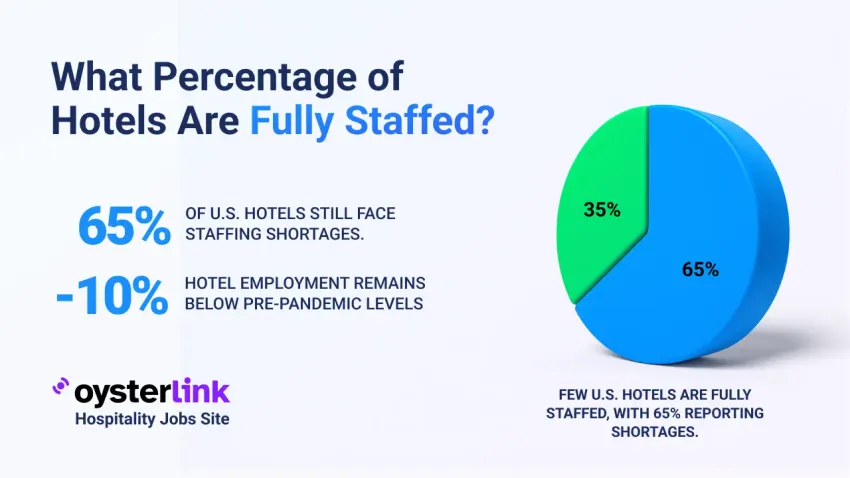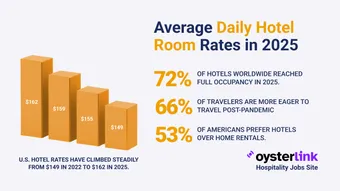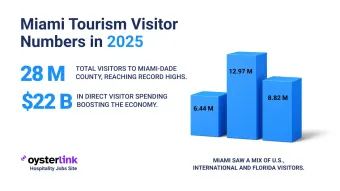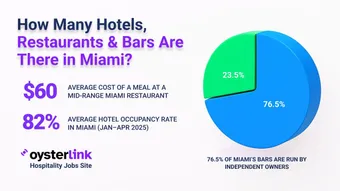These findings highlight how far the industry has come since the pandemic while showing that staffing challenges remain widespread.
Although the percentage of hotels that are fully staffed continues to rise, most properties are still working to rebuild their teams to pre-2020 levels.
What Percentage of Hotels Are Fully Staffed?
After years of labor shortages, hotels are gradually regaining staff, though most properties still face hiring challenges. The latest surveys show clear progress compared with the early pandemic recovery period.
- Roughly one in three hotels appear to be fully staffed, based on survey data showing 65% of properties still face staffing shortages as of early 2025.
- Among those surveyed, 9% described themselves as “severely understaffed,” down from 13% in May 2024.
- In May 2024, 76% of hotels reported shortages — a continued improvement from January 2023, when 79% were short-staffed and 22% said the shortages were severe.
- Looking further back, 87% of hotels were short-staffed in September 2022, and more than a third (36%) said they were severely short.
- Despite progress, total hotel employment remains nearly 10% below pre-pandemic levels, showing the sector’s recovery is still incomplete.
Hotel Staffing Trends Since the Pandemic
The hotel industry’s employment levels have gradually improved each year since the pandemic, but staffing still hasn’t returned to 2019 levels. The data below highlights how the workforce has slowly recovered over time.
- The U.S. hotel industry lost more than 682,000 direct employees in one year when the pandemic hit.
- Employment dropped from 2.35 million in 2019 to 1.67 million in 2020.
- Workforce levels began to recover slowly in 2021, reaching 1.78 million employees.
- By 2022, hotels employed 1.95 million people, still more than 400,000 fewer than in 2019.
- In 2023, hotel employment rose to 2.09 million, a 7.4% increase from 2022.
- Despite this growth, the industry remains about 260,000 employees below pre-pandemic levels.
- AHLA and its affiliates continue to promote workforce programs such as National Hotel Employee Day, the “A Place to Stay” campaign, and the Workforce & Immigration Initiative to attract new talent.
Hotel Staffing Shortages by Role and Department
While overall staffing levels are improving, shortages persist across departments, with some roles proving harder to fill than others.
- Housekeeping continues to be the toughest position, with 38% of hotels reporting shortages between December 2024 and January 2025.
- Earlier in 2024, half of all hotels (50%) ranked housekeeping as their top hiring need, underscoring how persistent the challenge has been.
- Front-desk positions also remain difficult to fill, with 26% of hotels reporting shortages.
- Shortages are less severe in culinary roles (14%) and maintenance positions (13%), but hotels continue to compete for talent across all service areas.
Reasons for Hotel Staffing Shortages
Even as demand for travel rebounds, hotels continue to face intense competition for workers. A tight labour market, strong travel demand, and challenging working conditions have all contributed to ongoing staffing difficulties.
- The U.S. labour market remains tight, with 8.1 million job openings and 6.5 million unemployed people as of April 2024, leaving hotels with a limited pool of workers to draw from.
- As a result, more than seven in 10 hotels (71%) said they had job openings they were unable to fill despite active searches, with an average of six to seven unfilled positions per property.
- At the same time, rising travel demand is adding pressure to fill those jobs, with U.S. hotels projected to exceed 1.3 billion occupied room nights in 2023 — surpassing pre-pandemic demand levels.
- Certain roles are especially difficult to staff. Housekeeping and front-desk positions remain hard to fill because they’re physically demanding and lower paid — Housekeepers earn a median of $17.20/hour, compared with $25.18 for all U.S. workers.
Strategies & Responses To Mitigate Hotel Staffing Gap
Hotels have steadily adjusted their hiring and retention strategies since 2023, moving from broad wage increases to more targeted incentives as shortages eased.
- In 2023, 81% of hotels said they were still unable to fill open positions despite higher pay and flexible schedules.
- As labour pressures peaked in early 2024, 86% of hotels increased wages, 52% offered more flexible hours and 33% expanded benefits.
- By mid-2024, over 85% continued to raise pay while adding new perks such as sign-on bonuses and improved benefits.
- By late 2024 and early 2025, efforts became more focused — 47% of hotels offered higher wages, 20% introduced flexible scheduling, 13% added hotel-stay discounts and 9% joined job fairs and recruitment advertising campaigns.
- Overall, hospitality wages have risen 32% since 2019, outpacing the 25% national average. As of March 2024, hotel employees earned an average of $23.76 per hour.
Encouragingly, 72% of hoteliers said career opportunities in hospitality are now as strong as or stronger than before the pandemic.
What Percentage of Hotels are Fully Staffed: Conclusion
The U.S. hotel industry has made steady progress in rebuilding its workforce, but full recovery is still out of reach. Staffing shortages are easing, yet key roles such as housekeeping and front-line service continue to challenge employers.
Higher wages, flexible schedules and improved benefits have helped attract and retain workers, although the industry still operates below pre-pandemic employment levels. Even so, growing optimism among hoteliers suggests that 2025 could mark a turning point toward a more stable and fully staffed hospitality workforce.
Industry Insights From OysterLink
As hotels work to rebuild their workforce and close remaining labour gaps, OysterLink supports the industry with data-driven insights that help hospitality employers navigate staffing challenges.
Beyond research on employment and wage trends, OysterLink connects hotels with qualified professionals through an easy-to-use job platform — helping businesses find talent and hospitality workers discover rewarding opportunities across the sector.










Loading comments...